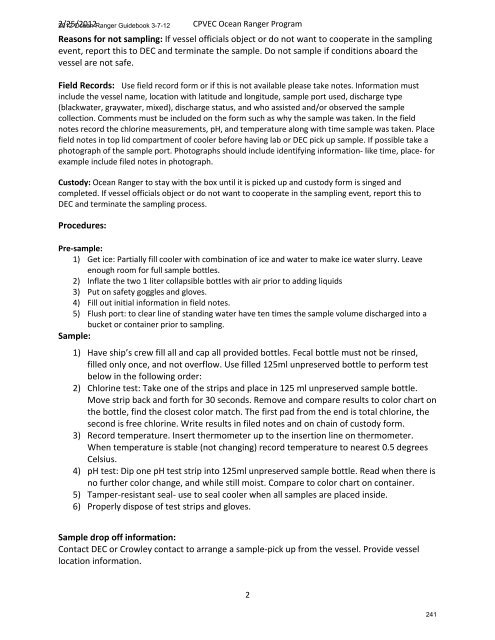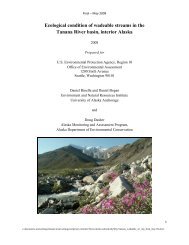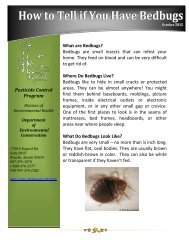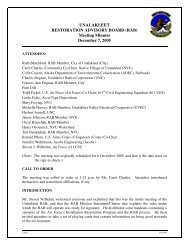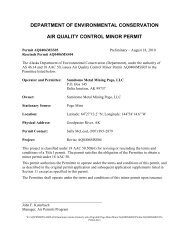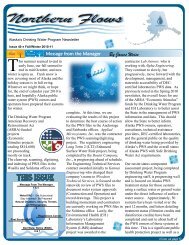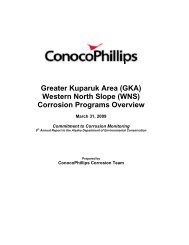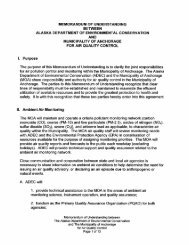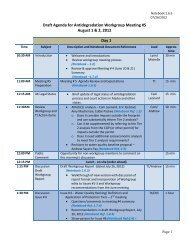2012 Ocean Ranger Guidebook Revision 3-7-12 - Alaska ...
2012 Ocean Ranger Guidebook Revision 3-7-12 - Alaska ...
2012 Ocean Ranger Guidebook Revision 3-7-12 - Alaska ...
Create successful ePaper yourself
Turn your PDF publications into a flip-book with our unique Google optimized e-Paper software.
2/25/<strong>20<strong>12</strong></strong> CPVEC <strong>Ocean</strong> <strong>Ranger</strong> Program<br />
<strong>20<strong>12</strong></strong> <strong>Ocean</strong> <strong>Ranger</strong> <strong>Guidebook</strong> 3-7-<strong>12</strong><br />
Reasons for not sampling: If vessel officials object or do not want to cooperate in the sampling<br />
event, report this to DEC and terminate the sample. Do not sample if conditions aboard the<br />
vessel are not safe.<br />
Field Records: Use field record form or if this is not available please take notes. Information must<br />
include the vessel name, location with latitude and longitude, sample port used, discharge type<br />
(blackwater, graywater, mixed), discharge status, and who assisted and/or observed the sample<br />
collection. Comments must be included on the form such as why the sample was taken. In the field<br />
notes record the chlorine measurements, pH, and temperature along with time sample was taken. Place<br />
field notes in top lid compartment of cooler before having lab or DEC pick up sample. If possible take a<br />
photograph of the sample port. Photographs should include identifying information- like time, place- for<br />
example include filed notes in photograph.<br />
Custody: <strong>Ocean</strong> <strong>Ranger</strong> to stay with the box until it is picked up and custody form is singed and<br />
completed. If vessel officials object or do not want to cooperate in the sampling event, report this to<br />
DEC and terminate the sampling process.<br />
Procedures:<br />
Pre-sample:<br />
1) Get ice: Partially fill cooler with combination of ice and water to make ice water slurry. Leave<br />
enough room for full sample bottles.<br />
2) Inflate the two 1 liter collapsible bottles with air prior to adding liquids<br />
3) Put on safety goggles and gloves.<br />
4) Fill out initial information in field notes.<br />
5) Flush port: to clear line of standing water have ten times the sample volume discharged into a<br />
bucket or container prior to sampling.<br />
Sample:<br />
1) Have ship’s crew fill all and cap all provided bottles. Fecal bottle must not be rinsed,<br />
filled only once, and not overflow. Use filled <strong>12</strong>5ml unpreserved bottle to perform test<br />
below in the following order:<br />
2) Chlorine test: Take one of the strips and place in <strong>12</strong>5 ml unpreserved sample bottle.<br />
Move strip back and forth for 30 seconds. Remove and compare results to color chart on<br />
the bottle, find the closest color match. The first pad from the end is total chlorine, the<br />
second is free chlorine. Write results in filed notes and on chain of custody form.<br />
3) Record temperature. Insert thermometer up to the insertion line on thermometer.<br />
When temperature is stable (not changing) record temperature to nearest 0.5 degrees<br />
Celsius.<br />
4) pH test: Dip one pH test strip into <strong>12</strong>5ml unpreserved sample bottle. Read when there is<br />
no further color change, and while still moist. Compare to color chart on container.<br />
5) Tamper-resistant seal- use to seal cooler when all samples are placed inside.<br />
6) Properly dispose of test strips and gloves.<br />
Sample drop off information:<br />
Contact DEC or Crowley contact to arrange a sample-pick up from the vessel. Provide vessel<br />
location information.<br />
2<br />
241


